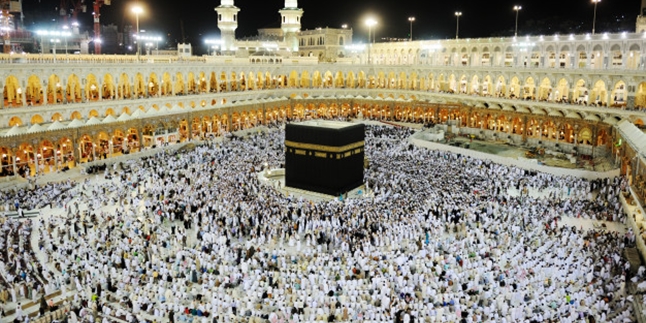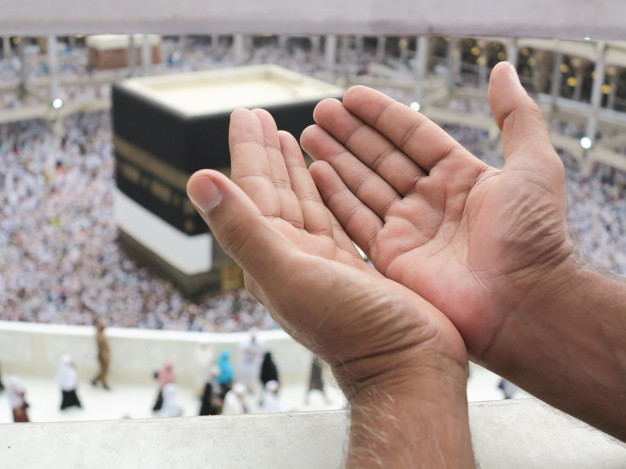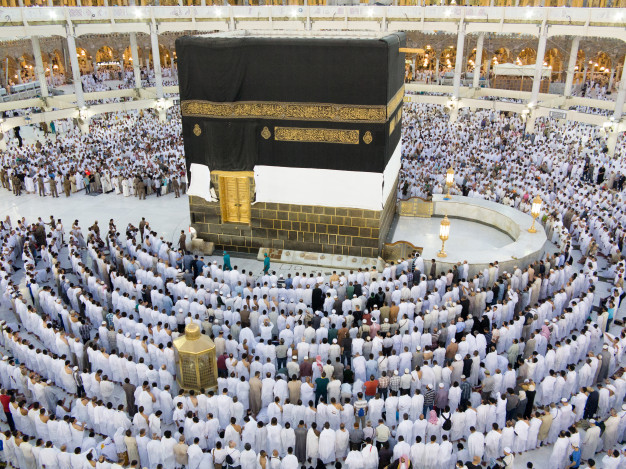Affirmation is a Way to Make Yourself More Positive with Words, Here Are the Steps
Affirmation is a practical way to influence oneself to become more positive. Read the deeper review here.

Kapanlagi.com - Hajj is one of the worship that at least performed once in a lifetime by every Muslim. And this worship becomes one of the dreams of many Muslims around the world. But before that, you must first know the procedures of Hajj before departing to perform this holy worship.
Hajj is one of the fifth pillars of Islam, and it is one of the noble worships. In Indonesia itself, if you want to perform Hajj, then you have to join the queue and wait for a considerable amount of time. Because in Indonesia, there are many people who are enthusiastic about performing Hajj every year.
READ ALSO: Idul Adha Prayer Equipped with Arabic Latin and Its Meaning
Another important thing that every Muslim who will perform Hajj should understand is to know the rituals or procedures of Hajj. Hajj rituals are simulations of Hajj worship that are performed according to the original procedures. And here, we have summarized various sources of Hajj worship procedures that you must and should know before departing to the holy land. Let's check it out KLovers.

Illustration (credit: Freepik)
Before you know the proper way of performing the Hajj, you must know the pillars of Hajj. Yes, the pillars of Hajj are obligatory acts that must be performed and cannot be replaced by paying a fine. If someone abandons one of the pillars of Hajj, the Hajj they perform is not valid. There are 6 pillars of Hajj, including:
1. Ihram or intention for Hajj
Ihram clothing for men consists of 2 pieces of unstitched cloth worn to cover the lower body, and another piece of cloth is worn as a shawl. Meanwhile, the Ihram clothing for women is to cover the entire body except the face and palms of the hands. The recommended color for Ihram clothing is white.
However, after wearing the Ihram clothing, Umrah pilgrims are prohibited from performing certain activities or wearing anything on their bodies, such as:
Prohibitions for Men:
- Wearing regular clothes
- Wearing footwear that covers the ankles
- Covering the head with a cap, hat, etc.
Prohibitions for Women:
- Wearing gloves
- Covering the face
Prohibitions for Men and Women:
- Wearing perfumes
- Cutting nails, shaving, or plucking hair
- Hunting or killing any animal
- Getting married, arranging a marriage, or proposing to a woman for marriage
- Engaging in affectionate acts or intimate relations
- Insulting, arguing, or using foul language
- Cutting plants around Mecca
After being ready with the preparations, the next step is to make the intention. Just like any other religious activities, you are also required to make an intention to perform the Hajj. And here is the intention that you need to recite:
"Labbaik Allahumma labbaik, labbaik laa syariika laka labbaik, inna al-hamda, wa ni'mata laka wa al-mulk Laa syariika laka"
Meaning: Here I am, O Allah, here I am answering Your call, here I am, there is no partner for You, here I am, indeed all praise, all blessings, and all sovereignty belong to You, there is no partner for You.
2. Standing at Arafah
It is performed on the 9th of Dhu al-Hijjah, starting from after sunset until dawn on the day of Nahr (the day of sacrifice) on the 10th of Dhu al-Hijjah. During the standing at Arafah, there are several things that need to be done, including:
- Performing combined and shortened Zuhr-Asr prayers
- Supplicating
- Remembrance of Allah together
- Reciting the Quran
- Performing combined prayers
- Shortening Maghrib until Isha prayers
3. Tawaf (circumambulation of the Kaaba)
Next is the tawaf, and here are some things that need to be done during the tawaf:
- Before entering Masjid al-Haram, it is recommended for the pilgrims to perform ablution first. The pilgrims can enter Masjid al-Haram through any gate, but it is recommended to follow the example of the Prophet Muhammad (peace be upon him) who entered through the Babus Salam or Bani Syaibah gate.
- When entering Masjid al-Haram, it is recommended to recite the prayer "Bismillah Wash Sholatu Was Salamu 'Ala Rasulullah. Allahummaftahli Abwaba Rahmatika"
Meaning: In the name of Allah, blessings and peace be upon the Messenger of Allah. O Allah, open the doors of Your mercy for me. Oh Allah, open for me the doors of Your mercy.
- After that, go down and continue towards the place of tawaf (mataf). The pilgrims start tawaf from a straight line (near the Black Stone) between the door of the Kaaba and the green light sign on the upper floor of Masjid al-Haram.
- Here, the pilgrims are given various options, including Taqbil, which is to kiss the Black Stone, Istilam and Taqbil, which is to touch, feel, and kiss the Black Stone. Wave the hands or the object we are holding three times, without kissing it, but saying Bismillah, Allahu Akbar (In the name of Allah, Allah is the Greatest).
Or one of these ritual options can be done every time passing by the Black Stone and Rukn Yamani during the first to seventh rounds. If unable to kiss the Black Stone and Rukn Yamani due to security reasons caused by the large number of pilgrims performing Umrah, then one can choose Istilam with the hands or an object, or simply wave the hands or the object we are holding.
- Then, during rounds 1-3, male pilgrims are encouraged to do a brisk walk. While during rounds 4-7, they walk at a normal pace. As for the procedure for Umrah for women, there is no brisk walk during tawaf.
- Throughout the tawaf, recite prayers while between Rukn Yamani and the Black Stone. The prayer always recited by Prophet Muhammad (PBUH) during tawaf is the sapu jagad prayer, which is:
"Rabbana Atina Fiddunya Hasanatan Wa Fil Akhirati Hasanata Wa Qina 'Adzabanar"
Meaning: Our Lord, grant us goodness in this world and goodness in the hereafter, and protect us from the punishment of the Hellfire.
4. Sa'i (running between the hills of Safa and Marwah)
There is also Sa'i as one of the pillars of Hajj.Sa'i itself is the activity of Sa'i and Tahallul.Sa'i is a small run between the hills of Safa and Marwah.When at the hill of Safa, the pilgrims are commanded to climb up the hill, then face the Kaaba from above.
Sa'i starts from Safa to Marwah, which is counted as one journey.So, Safa to Marwah 1, Marwah to Safa 2, and so on.Sa'i ends at Marwah.Sa'i is done by walking, but at the boundary between 2 green lights, it is a small run. And when performing Sa'i, you can recite prayers, as done by the Prophet Muhammad, such as:
Allahu akbar (3x),
Laa illaha illallahu wahdahulaa syariikalahuu, lahuulmulku wa lahuul hamdu yuhyii wa yumiitu wa huwa 'alaa kullii syai'in qadiir
Meaning: Allah is the Greatest, Allah is the Greatest, Allah is the Greatest.There is no deity worthy of worship except Allah alone, He has no partner.His is the dominion and His is the praise, He gives life and causes death, and He is over all things competent.
5.Cutting or shaving the hair
Then there is cutting or shaving the hair, usually known as Tahallul.Tahallul is the end of the Hajj worship, marked by shaving. For men, it is better to shave their heads completely, but if not completely shaved, it's okay. As for women, they only need to shave a little. By performing tahallul, the complete procedure of hajj according to the sunnah is fulfilled.
6. Orderliness
Orderliness is the last pillar of hajj, meaning that the pillars of hajj must be performed in sequence and cannot be skipped. For example, after performing tawaf, a hajj pilgrim should then perform Sa'i, it is not allowed to perform tahallul first and then Sa'i.
In addition to knowing the hajj pillars, you must also know the obligatory hajj, which are actions that must be performed in the hajj pilgrimage. If the obligatory hajj is violated, then the hajj is not valid unless the person pays dam (penalty) by slaughtering an animal.
The obligatory hajj consists of six, including:
1. Ihram or the intention to start the hajj pilgrimage from the miqat (designated boundary)
2. Mabit (staying overnight) in Muzdalifah on the night of the hajj festival
3. Stoning the three jamarat, namely: jamarat ula, jamarat wusta, and jamarat aqabah.
4. Mabit (staying overnight) in Mina
5. Tawaf wada' (farewell circumambulation)
6. Avoiding the prohibitions or actions forbidden during ihram such as:
- Men are prohibited from wearing stitched clothing.
- Covering the head for men and covering the face for women
- Killing game animals.
- Cutting nails.
- Using perfumes.
- Conducting marriage contracts.
- Engaging in sexual intercourse
- Cutting hair or other body hair.

Illustration (credit: Freepik)
After knowing the pillars and obligations of hajj, here are some mandatory procedures of hajj that you must know. And here are the procedures:
1. Before the 8th of Dhu al-Hijjah, all hajj pilgrims start performing the Hajj Tawaf at the Masjid al-Haram (Mecca).
2. The 8th of Dhu al-Hijjah (Tarwiyah Day) is called the Tarwiyah Day because the hajj pilgrims prepare enough provisions to go to Mina and Arafah, as there is no water source in both places.
3. The hajj pilgrims enter the state of ihram for the hajj rituals, starting with taking a bath, applying perfume, and wearing the ihram clothing while reciting the talbiyah.
4. They depart for Mina and after reaching Mina, they perform the Dhuhr, Asr, Maghrib, and Isha prayers, as well as the Fajr prayer. Each prayer is performed on time, but the four-rak'ah prayers are shortened to two rak'ahs. The pilgrims stay in Mina until sunrise on the 9th of Dzulhijjah.
5. On the morning of the 9th of Dzulhijjah, all the pilgrims head to the plain of Arafah to perform the standing (wukuf). Then all the pilgrims perform the worship of Wukuf, which is to stay and pray in the plain of Arafah until Maghrib arrives. It is recommended for the pilgrims to stop at Namirah and if possible, stay there until the sun sets, if possible.
Namirah is a place located near the border of Arafah. When the sun sets and enters the time of Zhuhr, it is recommended for the imam or the person delegated to deliver a sermon in front of the pilgrims regarding the condition of the Muslims, in order to renew the belief in the oneness of Allah, the laws regarding the rituals of Hajj, and other important matters.
6. The time for standing in Arafah starts from the dawn of the 9th of Dzulhijjah until the dawn of the 10th of Dzulhijjah. Whoever performs the standing during this time, even if it is brief, is considered to have performed the standing and their Hajj is valid.
Whoever does not perform the standing during this time, their Hajj is not valid, as narrated from Ibn 'Abbas in the Marfu' hadith, 'Whoever performs the standing before sunrise (on the 10th of Dzulhijjah), then they have performed Hajj.' [Authenticated by Al-Albani (No. 5995) in Shahihul Jami'.
7. On the night of the 9th of Dhu al-Hijjah, all Hajj pilgrims head to Muzdalifah to stay overnight and collect pebbles for stoning the pillars.
8. On the midnight of the 9th of Dhu al-Hijjah or after staying overnight in Muzdalifah, Hajj pilgrims continue their journey to Mina to perform the stoning of the pillars.
9. On the 10th of Dhu al-Hijjah, Hajj pilgrims perform the stoning of the pillars, which involves stoning the Jamarat Aqabah seven times as a symbol of driving away the devil. This is followed by Tahalul, which is shaving or trimming the hair.
10. If pilgrims choose to perform the early departure (nafar awal), they can proceed to Masjid al-Haram to perform the Tawaf of Hajj or complete their Hajj.
11. However, if they choose the late departure (nafar akhir), Hajj pilgrims stay in Mina and continue with the stoning of the pillars, namely Jamarat al-Ula and Jamarat al-Wustha.
12. On the 11th of Dhu al-Hijjah, Hajj pilgrims stone the pillars of Jamarat al-Ula at the first, second, and third pillars.
13. On the 12th of Dzulhijjah, the Hajj pilgrims throw pebbles at the first, second, and third pillars.
14. Then, the last thing the Hajj pilgrims do is return to Makkah to perform the Farewell Tawaf, which is the farewell circumambulation before returning to their respective countries.
Those are some of the hajj rituals that you should know before performing the hajj pilgrimage. Hopefully, knowing this will make it easier for you to perform the hajj and do it with devotion.
(kpl/dhm)
Cobain For You Page (FYP) Yang kamu suka ada di sini,
lihat isinya
Affirmation is a practical way to influence oneself to become more positive. Read the deeper review here.
For bird enthusiasts, chirping birds certainly receive special attention in the hearts of their fans. Well, for those of you who want to keep chirping birds, it's good to know the types of chirping birds first.
Here are some ways to determine the correct and accurate qibla direction for prayer. What are they? Let's check it out KLovers.
Reduce is an effort to tackle the problem of accumulating waste by reducing the use of goods. How is it explained? Find out in the following review.
In this world, there are various types of communicable diseases that are certainly very dangerous for the body. Therefore, you must be aware and cautious so as not to contract communicable diseases. Here are a series of easily transmittable diseases that you should be aware of.
To understand more deeply that tolerance is an attitude of mutual respect and appreciation of differences, you can read the following reviews.
The types of fabric used as materials for making clothes are indeed very diverse. Each type, of course, has different characteristics. So that you don't make mistakes when buying, here are the types of fabric used for clothes.
Being an editor sometimes requires creative, imaginative, and meticulous thinking in order to produce interesting and accurate works. Here are some super cool and creative editor quotes.
In medical terms, this condition is also known as tinnitus. The cause of ringing ears can occur due to various factors.
These are some procedures for umrah according to sharia that you must know. What are these procedures? Let's check it out KLovers.
Actually, there are several types of gymnastics that you can know. Where each type of gymnastics has its own characteristic movements and functions. Here are the types of gymnastics along with their benefits for health that you need to know.
Storyboard is a term commonly used to refer to sketch drawings arranged according to scenes or stories in a film or video script. Moreover, there are still many interesting things about storyboards that you need to know. Check out the review here.